When studying your stone, and planning how to best fit your maquette into the marble, you need to remember that you are drawing in Three Dimensions. This is easier said than done when you consider that you are dealing with an irregular shaped block that most likely has flaws.
- Pieta Maquette
- Marble Block with Fault
- Best Guess Pieta’s Position
The goal is to maximize the marble, minimize the work while doing your best to ensure that a nose does not slide off along a fault line, or dark vein does not run between the eyes.
Marble was once alive, created in part by trillions of barnacles, oysters and crabs. Then folded and pressed onto itself creating layers and swirls or solid tones depending on the mix of original ingredients.
Nothing in life is perfect, that’s part of the beauty. As artist we work within the natural boundaries of nature. We go with the flow. But no one likes surprises.. Kind of like enjoying a thunderstorm without being zapped by lighting.
And so it is with marble. We work with the natural form of the stone while ensuring these irregularities do not destroy our work.
With a human body, it is preferred to have a uniform tone… so random hidden discolorations or darkened veins can be a real problem. (unless you want to carve a sixth chakra or third nipple)
Early on in his career Michelangelo had little choice but to live with the flaws that the stone presented. Baccus, the Roman God of Wine and one of his earlier works, had discolorations that could not be avoided… veins running down his back and stains on the face… To Michelangelo artistic eye… these flaws forever marred the beauty of the piece.
Later, he would have the resources to purchase only the finest purest blocks and could throw away stone that was less than perfect. Michelangelo would spend months choosing the best quality Carrara marble and yet still he would find hidden disfiguring blemishes. These he would have to chip out or work around.
And so, I will be following the same process with my marble and my new Pieta.
My block has a major flaw running down on an angle. Along with this there are veins of darker harder stone flowing through along the line. I can imagine how this will affect the positioning of the Pieta, but can not be sure until I do a little probing. I have enough room within to rotate the statue with the fault in mind, but I also want to ensure that my Pieta when finished is as large as the stone block will allow. Positioning my design on a 45 degree angle will give me the space to carve a larger than life statue… but how will the flaw run? How deep? Does it tend to crack or does it simply blend in or fade away? Before I get too far into carving I will need to know.
- Cut Clean Prevents Cracks
- Hammer Chisel Outer Side
- Drill When You Trust Stone
After drawing boundary lines that mark the outside areas of excess stone I can start to explore the seriousness of the fault. The trick is not to make the crack worse… or create new fissures with thoughtless hammering. This is why I start with a clean saw cut. This serves to separate the shock of the chisel from stone that I want to preserve. Especially important when you’re not sure how natural fractures are running or are concealed. Once a line is cut, I can hammer away without the danger of bruising or damaging the carving section of marble.
- Feather and Wedges
- Clear Saw Cut Protects Stone
- Hammer Cuts Away
“Feather and Wedges” are the fastest way to split stone… but again, without full understanding of the hidden faults… I wanted to limit the distance of the final split.
- Does the Fault End?
- Continue to Probe
- Fault is Deep But Ends
Once I have exposed much of the flaw, it is apparent that it runs deeper and at a more radical angle than I had originally imagined. But it also seems not to run completely through the block. This new information means I have to rethink how I am going to position the Pieta..
Michelangelo considered his maquettes as guides only… he would often change his mind while carving to accommodate unforeseen flaws.
In my case, I am lucky that my maquette will fit neatly as I had planned though I will have to position Mother Mary on the fault line so that if this crack does show through, the line will flow along the curve of her back.
- Work with Flaw
- First Plan needs to Change
- Go with the Flow
This is why it’s best to move slowly and thoughtfully as you start the project. In the end, I have moved the layout almost 180 degrees from where I was to originally start carving. A complete reversal. And the statue will be a little smaller, though still life size. If I had started cutting without testing the nature of the stone, it is very possible that Jesus’ chest or hips could have fractured. Mary’s hips are wider and so if the fault does show, it will follow the curve and folds of her clothes.





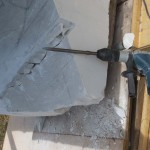
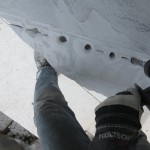
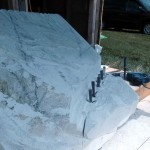
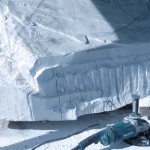
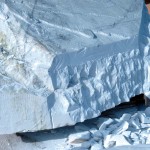
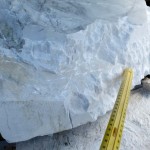
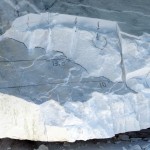
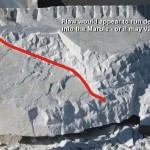
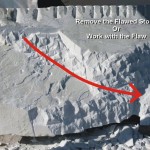
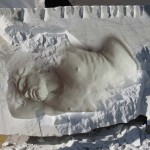
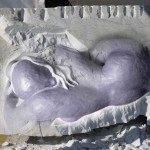
Pingback: Stress Testing Flaws in Marble | Pieta carved in marble